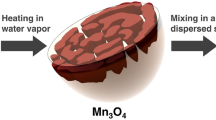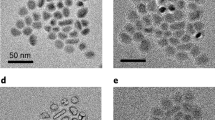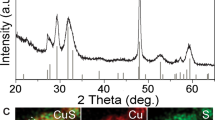Abstract
One of the major problems in the development of lithium-ion batteries is the relatively low capacity of cathode materials compared to anode materials. Owing to its high theoretical capacity, vanadium oxide is widely considered as an attractive cathode candidate. However, the main hindrances for its application in batteries are its poor capacity retention and low rate capability. Here, we report the development of multi-shelled vanadium oxide hollow microspheres and their related electrochemical properties. In contrast to the conventional cation-adsorption process, in which the metal cations adsorb on negatively charged carbonaceous templates, our approach enables the adsorption of metal anions. We demonstrate controlled syntheses of several multi-shelled metal oxide hollow microspheres. In particular, the multi-shelled vanadium oxide hollow microspheres deliver a specific capacity of 447.9 and 402.4 mAh g−1 for the first and 100th cycle at 1,000 mA g−1, respectively. The significant performance improvement offers the potential to reduce the wide capacity gap often seen between the cathode and anode materials.
This is a preview of subscription content, access via your institution
Access options
Subscribe to this journal
Receive 12 digital issues and online access to articles
$119.00 per year
only $9.92 per issue
Buy this article
- Purchase on Springer Link
- Instant access to full article PDF
Prices may be subject to local taxes which are calculated during checkout





Similar content being viewed by others
References
Wang, Y. & Cao, G. Z. Developments in nanostructured cathode materials for high-performance lithium-ion batteries. Adv. Mater. 20, 2251–2269 (2008).
Wang, K. X., Li, X. H. & Chen, J. S. Surface and interface engineering of electrode materials for lithium-ion batteries. Adv. Mater. 27, 527–545 (2015).
Wang, B., Wang, Y., Sun, B., Munroe, P. & Wang, G. X. Coral-like V2O5 nanowhiskers as high-capacity cathode materials for lithium-ion batteries. RSC Adv. 3, 5069–5075 (2013).
Idota, Y., Kubota, T., Matsufuji, A., Maekawa, Y. & Miyasaka, T. Tin-based amorphous oxide: a high-capacity lithium-ion-storage material. Science 276, 1395–1397 (1997).
Poizot, P., Laruelle, S., Grugeon, S., Dupont, L. & Tarascon, J.-M. Nano-sized transition-metal oxides as negative-electrode materials for lithium-ion batteries. Nature 407, 496–499 (2000).
Liang, Z. et al. Sulfur cathodes with hydrogen reduced titanium dioxide inverse opal structure. ACS Nano 8, 5249–5256 (2014).
Shao, J. et al. Low-cost synthesis of hierarchical V2O5 microspheres as high-performance cathode for lithium-ion batteries. ACS Appl. Mater. Interfaces 5, 7671–7675 (2013).
Qu, Q. T. et al. Porous LiMn2O4 as cathode material with high power and excellent cycling for aqueous rechargeable lithium batteries. Energy Environ. Sci. 4, 3985–3990 (2011).
Kang, B. & Ceder, G. Battery materials for ultrafast charging and discharging. Nature 458, 190–193 (2009).
Kim, K. M., Kim, J. C., Park, N. G., Ryu, K. S. & Chang, S. H. Capacity and cycle performance of a lithium-ion polymer battery using commercially available LiNiCoO2 . J. Power Sources 123, 69–74 (2003).
Zhao, X. R. et al. Structure design and performance of LiNixCoyMn1−x−yO2 cathode materials for lithium-ion batteries: a review. J. Chin. Chem. Soc. 61, 1071–1083 (2014).
Liu, Y. Y. et al. V2O5 nano-electrodes with high power and energy densities for thin film Li-ion batteries. Adv. Energy Mater. 1, 194–202 (2011).
Liu, Q. et al. Graphene-modified nanostructured vanadium pentoxide hybrids with extraordinary electrochemical performance for Li-ion batteries. Nature Commun. 6, 6127 (2015).
Chan, C. K. et al. Fast, completely reversible Li insertion in vanadium pentoxide nanoribbons. Nano Lett. 7, 490–495 (2007).
Shin, J., Jung, H., Kim, Y. & Kim, J. Carbon-coated V2O5 nanoparticles with enhanced electrochemical performance as a cathode material for lithium ion batteries. J. Alloys Compd. 589, 322–329 (2014).
Mai, L. Q. et al. Nanoflakes-assembled three-dimensional hollow-porous V2O5 as lithium storage cathodes with high-rate capacity. Small 10, 3032–3037 (2014).
Vu, A., Qian, Y. Q. & Stein, A. Porous electrode materials for lithium-ion batteries–how to prepare them and what makes them special. Adv. Energy Mater. 2, 1056–1085 (2012).
Wang, Z. Y., Zhou, L. & Lou, X. W. Metal oxide hollow nanostructures for lithium-ion batteries. Adv. Mater. 24, 1903–1911 (2012).
Wang, J. Y. et al. Accurate control of multishelled Co3O4 hollow microspheres as high-performance anode materials in lithium-ion batteries. Angew. Chem. Int. Ed. 52, 6417–6420 (2013).
Xu, S. M. et al. α-Fe2O3 multi-shelled hollow microspheres for lithium ion battery anodes with superior capacity and charge retention. Energy Environ. Sci. 7, 632–637 (2014).
Ren, H. et al. Multishelled TiO2 hollow microspheres as anodes with superior reversible capacity for lithium ion batteries. Nano Lett. 14, 6679–6684 (2014).
Wang, J. Y. et al. pH-regulated synthesis of multi-shelled manganese oxide hollow microspheres as supercapacitor electrodes using carbonaceous microspheres as templates. Adv. Sci. 1, 1400011 (2014).
Yue, Q., Jiang, H., Hu, Y. J., Jia, G. Q. & Li, C. Z. Mesoporous single-crystalline V2O5 nanorods assembled into hollow microspheres as cathode materials for high-rate and long-life lithium-ion batteries. Chem. Commun. 50, 13362–13365 (2014).
Zheng, Y. Z. et al. Nickel-mediated polyol synthesis of hierarchical V2O5 hollow microspheres with enhanced lithium storage properties. J. Mater. Chem. A 3, 1979–1985 (2015).
Su, D. W., Dou, S. X. & Wang, G. X. Hierarchical orthorhombic V2O5 hollow nanospheres as high performance cathode materials for sodium-ion batteries. J. Mater. Chem. A 2, 11185–11194 (2014).
Glushenkov, A. M. et al. Growth of V2O5 nanorods from ball-milled powders and their performance in cathodes and anodes of lithium-ion batteries. J. Solid State Electrochem. 14, 1841–1846 (2014).
Cao, A. M., Hu, J. S., Liang, H. P. & Wan, L. J. Self-assembled vanadium pentoxide (V2O5) hollow microspheres from nanorods and their application in lithium-ion batteries. Angew. Chem. Int. Ed. 44, 4391–4395 (2005).
Li, Y. W. et al. Leaf-like V2O5 nanosheets fabricated by a facile green approach as high energy cathode material for lithium-ion batteries. Adv. Energy Mater. 3, 1171–1175 (2013).
Pham-Cong, D. et al. Cathodic performance of V2O5 nanowires and reduced graphene oxide composites for lithium ion batteries. Curr. Appl. Phys. 14, 215–221 (2014).
Rui, X. H. et al. Ultrathin V2O5 nanosheet cathodes: realizing ultrafast reversible lithium storage. Nanoscale 5, 556–560 (2013).
Uchaker, E., Zhou, N., Li, Y. W. & Cao, G. Z. Polyol-mediated solvothermal synthesis and electrochemical performance of nanostructured V2O5 hollow microspheres. J. Phys. Chem. C 117, 1621–1626 (2013).
Lai, X. Y. et al. General synthesis and gas-sensing properties of multiple-shell metal oxide hollow microspheres. Angew. Chem. Int. Ed. 50, 2738–2741 (2011).
Dong, Z. H. et al. Accurate control of multishelled ZnO hollow microspheres for dye-sensitized solar cells with high efficiency. Adv. Mater. 24, 1046–1049 (2012).
Dong, Z. H. et al. Quintuple-shelled SnO2 hollow microspheres with superior light scattering for high-performance dye-sensitized solar cells. Adv. Mater. 26, 905–909 (2014).
Zeng, X. M., Zhao, K., Si, S., Liang, F. & He, Q. Adsorption of vanadium with 312 resin. Chin. J. Rare Met. 33, 446–449 (2006).
Sugimoto, T. & Muramatsu, A. Formation mechanism of monodispersed α-Fe2O3 particles in dilute FeCl3 solutions. J. Colloid Interface Sci. 184, 626–638 (1996).
Patrick, J. W. & Walker, A. A. A study of the copper-catalysed combustion of carbon. Carbon 12, 507–515 (1974).
Hu, Y. et al. Growth of high-density horizontally aligned SWNT arrays using Trojan catalysts. Nature Commun. 6, 6099 (2014).
Straub, D., Graue, R., Heitmeir, F., Nebendahl, P. & Wurst, Th. K. Fick’s First Law correction by an exact solution of the Boltzmann equation. Propellants Explos. Pyrotech. 12, 105–112 (1987).
Peng, Z. L. et al. Fresh frozen plasma lessens pulmonary endothelial inflammation and hyperpermeability after hemorrhagic shock and is associated with loss of Syndecan 1. Shock 40, 195–202 (2013).
Shyue, J.-J. & Guire, M. R. D. Deposition of titanium-vanadium oxide thin films on organic self-assembled monolayers: role of complexing agents. Chem. Mater. 17, 5550–5557 (2005).
Shin, J. Y., Kim, T. Y., Je, J. W., You, T.-S. & Kim, J. S. Facile synthesis and electrochemical performance of carbon-coated V2O5 cathode materials using carboxylic acids as carbon source. Electrochim. Acta 139, 408–414 (2014).
Gao, L. S. et al. Synthesis and electrochemical properties of nanocrystalline V2O5 flake via a citric acid-assistant sol–gel method. J. Cryst. Growth 281, 463–467 (2005).
Wu, H. B., Pan, A. Q., Hng, H. H. & Lou, X. W. Template-assisted formation of rattle-type V2O5 hollow microspheres with enhanced lithium storage properties. Adv. Funct. Mater. 23, 5669–5674 (2013).
Pan, A. Q., Wu, H. B., Yu, L. & Lou, X. W. Template-free synthesis of VO2 hollow microspheres with various interiors and their conversion into V2O5 for lithium-ion batteries. Angew. Chem. Int. Ed. 52, 2226–2230 (2013).
Pan, A., Zhu, T., Wu, H. B. & Lou, X. W. Template-free synthesis of hierarchical vanadium-glycolate hollow microspheres and their conversion to V2O5 with improved lithium storage capability. Chem. Eur. J. 19, 494–500 (2013).
Pan, A. Q., Wu, H. B., Zhang, L. & Lou, X. W. Uniform V2O5 nanosheet-assembled hollow microflowers with excellent lithium storage properties. Energy Environ. Sci. 6, 1476–1479 (2013).
Du, G. D. et al. Graphene–V2O5 ⋅ nH2O xerogel composite cathodes for lithium ion batteries. RSC Adv. 1, 690–697 (2011).
Zhang, J. G., McGraw, J. M., Turner, J. & Ginley, D. Charging capacity and cycling stability of VOx films prepared by pulsed laser deposition. J. Electrochem. Soc. 144, 1630–1634 (1997).
Dylla, A. G., Henkelman, G. & Stevenson, K. J. Lithium insertion in nanostructured TiO2(B) architectures. Acc. Chem. Res. 46, 1104–1112 (2013).
Frisch, M. J. et al. Gaussian 09, Version A.02 (Gaussian, 2009).
Raju, V. et al. Superior cathode of sodium-ion batteries: orthorhombic V2O5 nanoparticles generated in nanoporous carbon by ambient hydrolysis deposition. Nano Lett. 14, 4119–4124 (2014).
Sathiya, M., Prakash, A. S., Ramesha, K., Tarascon, J.-M. & Shukla, A. K. V2O5-anchored carbon nanotubes for enhanced electrochemical energy storage. J. Am. Chem. Soc. 133, 16291–16299 (2011).
Acknowledgements
This work was supported financially by the National Natural Science Foundation of China (No. 51172235, 21203201, 51202248, 21201167, 51272165, 51372245, 51302266, 51472244, 51572261, 21401199, 51362024 and 21590795), National Science Fund for Distinguished Young Scholars (No. 21325105) and Australian Research Council (ARC) Discovery Project (No. 160104817). This research was undertaken on the National Computation Infrastructure (NCI) in Canberra, Australia.
Author information
Authors and Affiliations
Contributions
D.W. and R.Y. proposed and guided the research project. J.W. and H.T. designed and performed the experiments. L.Z., Y.Wang and H.Z. did the modelling and calculations. D.W., R.Y., Y.Z. and J.W. analysed the experimental results and drafted the manuscript. Z.T. and H.Z. improved the writing of the manuscript. H.R., Q.J., J.Q., D.M., M.Y., P.L., Y.Wen, L.G., G.M. and Z.S. gave some helpful advice.
Corresponding authors
Ethics declarations
Competing interests
The authors declare no competing financial interests.
Supplementary information
Supplementary Information
Supplementary Figures 1–23, Supplementary Tables 1–7, Supplementary References. (PDF 3984 kb)
Rights and permissions
About this article
Cite this article
Wang, J., Tang, H., Zhang, L. et al. Multi-shelled metal oxides prepared via an anion-adsorption mechanism for lithium-ion batteries. Nat Energy 1, 16050 (2016). https://doi.org/10.1038/nenergy.2016.50
Received:
Accepted:
Published:
DOI: https://doi.org/10.1038/nenergy.2016.50
This article is cited by
-
Hollow multishelled structural ZnO fillers enhance the ionic conductivity of polymer electrolyte for lithium batteries
Journal of Nanoparticle Research (2023)
-
Hollow multishelled structural TiN as multi-functional catalytic host for high-performance lithium-sulfur batteries
Nano Research (2023)
-
By self-assembly of electrostatic attraction to encapsulate protective carbon-coated nano-Si into graphene for lithium-ion batteries
Ionics (2022)
-
The development of hollow multishelled structure: from the innovation of synthetic method to the discovery of new characteristics
Science China Chemistry (2022)
-
Inorganic-organic competitive coating strategy derived uniform hollow gradient-structured ferroferric oxide-carbon nanospheres for ultra-fast and long-term lithium-ion battery
Nature Communications (2021)



